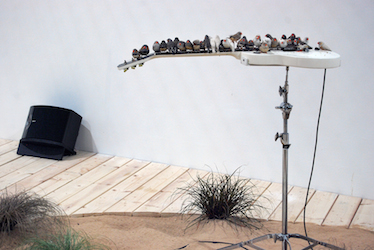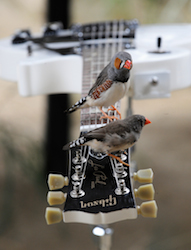from here to ear, an installation currently on view at the Peabody Essex Museum (PEM) in Salem, Massachusetts, is a breakthrough sonic experience by French artist Céleste Boursier-Mougenot. Wildly popular overseas, this site-specific gallery-turned-aviary premiered at PEM for the first time in the United States. Produced in various forms since 1995, Boursier-Mougenot’s multi-sensory installation at PEM consists of materials that may be considered unusual for a museum exhibition: a flock of 70 live zebra finches; 10 Les Paul Studio Electric Guitars (white) and 14 Thunderbird IV Basses (black) (both made by Gibson); 14 amplifiers; 7 cymbals (used as feeding stations); tufts of grass; and 3 large nest condos, each constructed from 50 individual bamboo nests.
Staged in the museum’s 2,200-square-foot Barton Gallery, the installation also required the procurement of 23,000 pounds of sand, 800 square-feet of aviary netting, 220 chains for the layer of double chainmail curtains at the entry/exit points, 8 special ultraviolet lighting panels, an automatic light dimmer system, and 20 medium density fiberboard (MDF) platforms that serve as the walkways for visitors. And, hidden behind a closed door is a quarantine room which holds 50+ pounds of bird seed, multiple gallons of water, “time-out” cages for the birds, disinfectants, cleaning supplies, personal protective equipment (PPE), and an emergency protocol sheet, including the phone number of the museum’s on-call resident veterinarian.

Installation for The Curve, Barbican Art Gallery, 2010. Celeste Boursier-Mougenot. Photo AFP/Getty Images
These complex components go unnoticed by visitors to the gallery. The space itself feels expansive – an even bright white light casts upon you and the finches, who freely explore their habitat – eating, nesting, and perching on the amplified instruments. Museum-goers wander with delight, often pausing to observe the finches’ behavior as they listen to the constantly changing harmonic environment.
from here to ear is not a new piece, but one that is in constant evolution, each time adapted by the artist to a new space’s configuration. PEM’s installation is version seventeen and as popular as the sixteen versions before it. Visitors waited in queues for over two hours long on opening weekend and the timed tickets continue to sell out every weekend!
In 2012 Boursier-Mougenot visited PEM to discuss the project, its unique requirements, and physically experience the gallery. The artist returned to France, where he would sketch the design; the museum would be responsible for executing the construction design.
The predetermined structural factors of the gallery were important, perhaps in hindsight more significant than one can even describe here.
The finches populate Barton Gallery, a self-contained space with an independent air exchange HVAC system that vents outside. The air quality in the aviary is strictly monitored and the required filtration in place throughout the 12-week exhibition run. This factor gave the museum confidence that the project could be executed safely and what occurred over the next year was a series of exhaustive, yet gratifying, conversations about the logistics to orchestrate and transform a gallery into an aviary for from here to ear.

Celeste Boursier-Mougenot, From Here to Ear installation for Nantes Creation Estuary, 2009. Photo: Frank Perry/AFP/Newscom
As per the artist’s specification, PEM provided a flock of zebra finches, equally male and female. Explaining the installation and desire for untrained animals made for interesting conversations with the professional animal trainers (who regularly train parrots, dogs, elephants, monkeys, among others, for theatrical performances, advertisements, and films) who supplied the flock. The museum only needed to ensure the finches were professionally bred, health certified, and available for four months in 2014. The finches arrived in Salem to acclimatize in the aviary and meet the artist, who spent two weeks observing their flight patterns, repositioning the equipment in response, tuning the guitars, and programming the amps. The finches will return to their breeder once the installation has finished.
Unlike prior presentations, from here to ear is installed at PEM without a great deal of natural light. The finches’ livelihood mandates maintaining a healthy circadian rhythm. PEM’s designers, electrician, and facility managers were challenged to fabricate a dimmable system in a gallery whose lighting tracks were not dimmable. The resulting suspended lighting track of ultraviolet (UV) light panels operates on a programmed timer to gradually come up in the morning and down again in the evening.
To our great surprise an exotic bird specialist practiced in Salem and within a mile of the museum. Dr. Elizabeth Bradt, of All Creatures Veterinary Hospital, agreed to meet and discuss the project. Her immediate enthusiasm and interest was infectious – her support and long-term expertise indispensable. She visits the birds weekly and remains on call at all times. PEM also hired gallery interpreters to oversee the finches’ well-being, tune guitars, and clean the aviary on a daily basis. Unlike other installations, the interpreters remain in the space at all times to interact with curious museum-goers.
Everything was in progress or nearly finalised – the design, lighting tracks, finches, veterinarian – even the shipping arrangements for the instruments from the artist’s studio in Sète, France were in motion. Then our trusted electrician identified a power supply issue in the gallery. The amount of power necessary to convert the European models would exceed the power consumption capabilities of the space. Creative problem solving ensued; electrical floor plans assessed and reassessed, but ultimately the risk of short-circuiting the equipment was far too great. New U.S. models of Gibson guitars and basses, amps, cymbals, extra strings, power cords, etc. were specified and to be ordered. Thanks to one staff member’s nephew, who just happened to work for Guitar Center in Los Angeles and just happened to welcome a new partnership with the museum from his native east coast, PEM received V.I.P. treatment and the equipment arrived in Salem on time.
While from here to ear asks us to reconsider traditional notions of artistic collaboration, it also asks us to explore the many hands, minds, talents, feet, and beaks that played a part in this extraordinary installation.
Back to top




